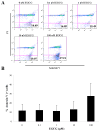Preclinical development of the green tea catechin, epigallocatechin gallate, as an HIV-1 therapy - PubMed (original) (raw)
Preclinical development of the green tea catechin, epigallocatechin gallate, as an HIV-1 therapy
Christina L Nance et al. J Allergy Clin Immunol. 2009 Feb.
Abstract
Background: Previously, we presented evidence that at physiologic concentrations the green tea catechin, epigallocatechin gallate (EGCG), inhibited attachment of HIV-1 glycoprotein 120 to the CD4 molecule on T cells, but the downstream effects of EGCG on HIV-1 infectivity were not determined.
Objective: To evaluate the inhibition of HIV-1 infectivity by EGCG and begin preclinical development of EGCG as a possible therapy.
Methods: PBMCs, CD4(+) T cells, and macrophages were isolated from blood of HIV-1-uninfected donors. HIV-1 infectivity was assessed by an HIV-1 p24 ELISA. Cell survival was assessed by cell viability by Trypan blue exclusion assay, cell growth by thymidine incorporation, and apoptosis by flow-cytometric analysis of annexin-V binding.
Results: Epigallocatechin gallate inhibited HIV-1 infectivity on human CD4(+) T cells and macrophages in a dose-dependent manner. At a physiologic concentration of 6 mumol/L, EGCG significantly inhibited HIV-1 p24 antigen production across a broad spectrum of both HIV-1 clinical isolates and laboratory-adapted subtypes (B [P < .001], C, D, and G [P < .01]). The specificity of the EGCG-induced inhibition was substantiated by the failure of EGCG derivatives lacking galloyl and/or pyrogallol side groups to alter HIV-1 p24 levels. EGCG-induced inhibition of HV-1 infectivity was not a result of cytotoxicity, cell growth inhibition, or apoptosis.
Conclusion: We conclude that by preventing the attachment of HIV-1-glycoprotein 120 to the CD4 molecule, EGCG inhibits HIV-1 infectivity. Because this inhibition can be achieved at physiologic concentrations, the natural anti-HIV agent EGCG is a candidate as an alternative therapy in HIV-1 therapy.
Figures
FIG 1
EGCG-induced inhibition of HIV-1 infectivity. HIV-1 p24 antigen production in freshly isolated human CD4+ T cells (●) and macrophages (▲) was measured by ELISA with subtype B, R5-HIV-1Ba-L for 7 days in the presence of EGCG, medium, control catechin, (−)-catechin, or ritonavir. The data are expressed as means ±SD of three separate experiments.
FIG 2
Effect of catechins on HIV-1 p24 antigen production in human lymphocytes. HIV-1 p24 antigen production was measured in the presence and absence of the green tea catechins, (−)-catechin, ECG, EGC, and EGCG at 50μM and the black tea catechin, theaflavin at 20μM. The data are expressed as means ±SD of three separate experiments.
FIG 3
EGCG inhibition of HIV-1 p24 antigen production in human macrophages using different HIV-1 subtypes; A) subtype B, R5-HIV-1SF162, B) subtype B, R5/X4-HIV-189.6, C) subtype D, X4-HIV-192UG038 and D) subtype G, R5-HIV-1JV1083. The data are expressed as means ±SD of three experiments for A) and B); of two experiments for C) and D)..
FIG 4
Effect of EGCG on apoptosis of human lymphocytes. Flow cytometric determination of apoptosis on PBMC after 24 hours in the presence or absence of EGCG. A) Representative histogram of Annexin-V (x-axis) and PI (y-axis) staining. Percent Annexin +/PI− are indicated in quadrant 4. B) Graphic representation of histogram data in A compared to baseline. A) representative of two experiments and B) expressed as means ±SD.
Similar articles
- Epigallocatechin gallate, the main polyphenol in green tea, binds to the T-cell receptor, CD4: Potential for HIV-1 therapy.
Williamson MP, McCormick TG, Nance CL, Shearer WT. Williamson MP, et al. J Allergy Clin Immunol. 2006 Dec;118(6):1369-74. doi: 10.1016/j.jaci.2006.08.016. Epub 2006 Oct 13. J Allergy Clin Immunol. 2006. PMID: 17157668 - Green tea catechin, epigallocatechin-3-gallate (EGCG): mechanisms, perspectives and clinical applications.
Singh BN, Shankar S, Srivastava RK. Singh BN, et al. Biochem Pharmacol. 2011 Dec 15;82(12):1807-21. doi: 10.1016/j.bcp.2011.07.093. Epub 2011 Jul 30. Biochem Pharmacol. 2011. PMID: 21827739 Free PMC article. Review. - Epigallocatechin-3-gallate regulates cell growth, cell cycle and phosphorylated nuclear factor-κB in human dermal fibroblasts.
Han DW, Lee MH, Kim HH, Hyon SH, Park JC. Han DW, et al. Acta Pharmacol Sin. 2011 May;32(5):637-46. doi: 10.1038/aps.2011.17. Epub 2011 Apr 25. Acta Pharmacol Sin. 2011. PMID: 21516136 Free PMC article. - Green tea polyphenol epigallocatechin 3-gallate in arthritis: progress and promise.
Ahmed S. Ahmed S. Arthritis Res Ther. 2010;12(2):208. doi: 10.1186/ar2982. Epub 2010 Apr 28. Arthritis Res Ther. 2010. PMID: 20447316 Free PMC article. Review.
Cited by
- Sulforaphane Inhibits HIV Infection of Macrophages through Nrf2.
Furuya AK, Sharifi HJ, Jellinger RM, Cristofano P, Shi B, de Noronha CM. Furuya AK, et al. PLoS Pathog. 2016 Apr 19;12(4):e1005581. doi: 10.1371/journal.ppat.1005581. eCollection 2016 Apr. PLoS Pathog. 2016. PMID: 27093399 Free PMC article. - Epigallocatechin-3-Gallate, the Main Polyphenol in Green Tea, Inhibits Porcine Epidemic Diarrhea Virus In Vitro.
Huan C, Xu W, Ni B, Guo T, Pan H, Jiang L, Li L, Yao J, Gao S. Huan C, et al. Front Pharmacol. 2021 Feb 22;12:628526. doi: 10.3389/fphar.2021.628526. eCollection 2021. Front Pharmacol. 2021. PMID: 33692691 Free PMC article. - Epigallocatechin-3-gallate rapidly remodels PAP85-120, SEM1(45-107), and SEM2(49-107) seminal amyloid fibrils.
Castellano LM, Hammond RM, Holmes VM, Weissman D, Shorter J. Castellano LM, et al. Biol Open. 2015 Aug 28;4(9):1206-12. doi: 10.1242/bio.010215. Biol Open. 2015. PMID: 26319581 Free PMC article. - (-)-Epigallocatechin-3-Gallate Enhances Hepatitis C Virus Double-Stranded RNA Intermediates-Triggered Innate Immune Responses in Hepatocytes.
Wang Y, Li J, Wang X, Peña JC, Li K, Zhang T, Ho W. Wang Y, et al. Sci Rep. 2016 Feb 16;6:21595. doi: 10.1038/srep21595. Sci Rep. 2016. PMID: 26879672 Free PMC article.
References
- Wang R, Gu Q, Wang Y, Zhang X, Yang L, zhou J, et al. Anti-HIV-1 activities of compounds isolated from the medicinal plant Rhus chinensis. Journal of Ethnopharmacology. 2008;117(2):249–56. - PubMed
- Wu J, Wang X, Yi Y, Lee K. Anti-AIDS agents 54. A potent anti-HIV chalcone and flavonoids from genus Desmos. Bioorg Med Chem Lett. 2003a;13:1813–5. - PubMed
Publication types
MeSH terms
Substances
LinkOut - more resources
Full Text Sources
Other Literature Sources
Medical
Research Materials



